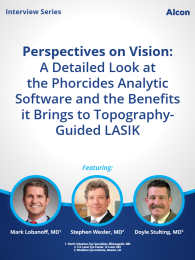

Introduction
Topography-guided laser-assisted in-situ keratomileusis (LASIK) considers the shape of the anterior corneal surface and uses corneal curvature data from preoperative corneal topography measures. These treatment profiles help reduce higher order aberrations (including spherical aberration) by compensating for cosine effect and by normalizing the overall surface of the cornea. This is done by flattening elevations and relatively steepening flatter areas by ablating around them.
Determining the correct sphere magnitude, cylinder magnitude and cylinder axis for treatment with topography- guided LASIK has been a dilemma among surgeons. With the recent introduction of the Phorcides analytic software, treatment planning can be simplified and the treatment accurately calculated with the exact treatment profile required without further calculations by the surgeon (Lobanoff 2020, Stulting 2020).
Mark Lobanoff, MD, Stephen Wexler, MD and Doyle Stulting, MD discuss Phorcides technology and the clinical benefits it brings to topography-guided LASIK.


